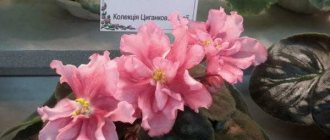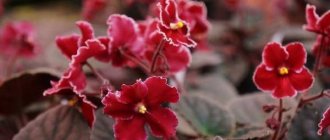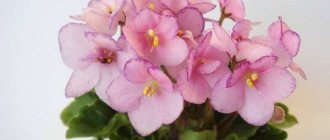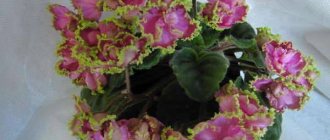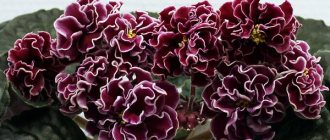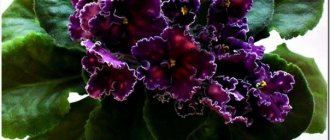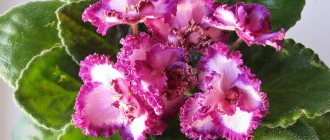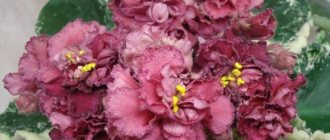Delicate, bright violets took pride of place on the windowsills and shelves of apartments. differ from their relatives growing in natural conditions :
- Long flowering;
- Bright and varied colors;
- And resistance to various environmental factors.
But the most unpretentious variety, with poor care, will not grow with a neat symmetrical rosette and will not produce beautiful cap blooms. Therefore, it is so important to know and follow the recommendations for caring for the Uzambara violet variety.
Violet SM-Almond (Seedling Morev)
History of the variety
Saintpaulia SM-Almond is a seedling of the famous domestic breeder Konstantin Morev .
Despite the fact that Konstantin did not make this hybrid of Uzambara violet a variety, SM-Almond for its bright and large flowers became very popular among:
- Violet collectors;
- And lovers of indoor flowers.
Photo and description of the variety
Violet Moreva Almond is an Uzambara violet that belongs to the Gesneriev family . The Almond seedling delights not only beginners, but also experienced violet growers. Simply huge flowers up to 8-9 cm, amaze not only with their size, but also with their changing color depending on the conditions of detention.
Flowers are found in two color options . In the first case they are a rich coral color, and in the second they are soft peach. Double stars also have a white center, and the edges of the petals are gracefully curved and lighter than the middle.
Violet Almond has two different flower colors.
Attention! Thanks to the dense structure of the petals, the flowers retain their shape throughout the entire flowering period.
Socket:
- Compact and symmetrical;
- Easy to form;
- It has a standard size of 30 to 40 cm in diameter.
Leaves:
- Shiny;
- Round shape;
- Dark green color;
- The edges of the foliage have faint serrations.
Saintpaulia has dark green leaves.
Variegation, imprints
The rosette and leaves are of a standard dark green color, without variegation .
Types and varieties of almonds with photos
- Triloba almond (Louisiania triloba) – spreading crown. Its height sometimes reaches 3 meters. The leaves have large teeth along the edges. Their surface, when they open, has a fleecy structure. The flowers are small.
- Rosemund almond - blooms for quite a long time with pink double flowers of miniature size.
- Tanyusha almonds are double flowers with curled petals. Flowers - 2.5-3.5 centimeters.
- Stonefly almonds are disease resistant. Known for its decorative properties.
- Georgian almond - grows on the edges and in hollows. Its height is 1 meter. The length of the leaves is 8 centimeters. The flowers are big. This almond is winter-hardy. It is often used by breeders.
- Ruslana almond is a hybrid. Flesh flowers turn almost white when finished.
Caring for a plant at home
The variety is not particularly capricious and, with the right choice of location, proper watering and use of fertilizers, does not require additional attention.
Important! Critical temperatures for violets are below 13 and above 28 degrees.
Conditions of detention
If the rosette is on the windowsill and is not regularly turned with opposite sides to the light source, then the rosette begins to twist the leaves in different directions . With age, the rosette noticeably stretches the stem, so it will have to be replanted often.
This variety can be grown both on a windowsill and on a shelf.
Proper watering and fertilizing
The variety does not like waterlogging . It requires moderate watering and even short-term maintenance in soil that is too waterlogged leads to partial death of the delicate root system of the violet. And regular overwatering can easily destroy even an adult plant.
Experienced gardeners recommend growing this variety using wick irrigation.
Fertilizing is carried out regularly , twice a month during the period of active growth and flowering.
Lighting and temperature
The violet is sensitive to indoor lighting; the best option for growing SM-Almonds is a backlit rack . If you grow a flower on a windowsill, then the east window will be the best choice.
The Almond seedling is also dependent on the room temperature . At the peak of the heat, the petals become monotonous, without whiteness in the center of the flower and along the edges of the petals.
Important! The petals have their varietal color at a temperature of 20-24 degrees.
Air humidity
The humidity in the room should be between 50-70% , if higher or lower, the violet will feel discomfort and bloom poorly.
What kind of soil does he prefer?
The substrate for planting violets is needed :
- Air;
- And loose.
For the plant, they buy a ready-made slightly acidic substrate and add baking powder to it:
- Perlite;
- Or vermiculite.
For rosettes standing on wick watering, use a 1:1 ratio, and for top watering, use a mixture of one part baking powder and three parts soil for violets or high-moor peat.
Pruning and hygiene
Once a month, the violet is given “bath procedures” . The plant is washed off with dust under a weak stream of water. The water temperature should be the same as when watering, and its temperature should not be lower than room temperature.
After “bathing,” the violet is placed in its usual place after the foliage has completely dried. Otherwise, the remaining drops will lead to rotting of the rosette or senile burns, and subsequently the beautiful leaves will be spoiled by yellow spots .
Reproduction methods
The presented variety is propagated by leaf cuttings.
Although the variety is a little slow to reproduce, the babies grow very slowly , but it is worth noting that the variety reproduces well:
- By pinching;
- And leaf cuttings.
If desired, it can also be propagated by planting flower stalks .
Rules for transplantation and rejuvenation
Transplant the rosette into new soil:
- Every six months;
- Or after every third flowering.
Rejuvenate violet:
- Cutting the plant at the root;
- And the flower stalks are removed along with the lower leaves.
The bottom of the stem is peeled like a carrot and placed in a greenhouse until young roots appear.
One species or a group of different species and varieties?
Over several centuries of active cultivation of violets by flower growers of the Old World and Russia, many new species of this delicate plant were bred - by the beginning of the 21st century, according to the Royal Horticultural Society (Great Britain), 21 species were used in gardening and landscape art.
Based on the basic species, breeders continue to grow magnificent varieties and hybrids of violas, distinguished by:
- Bright colors;
- Lasting aroma;
- And large flowers.
One species of garden pansy (Wittrock's viola) alone has about 500 bred forms.
Also, do not forget that white violet will look very beautiful and delicate in your gardens. The entire variety of violets used to decorate garden plots and public parks are commonly called garden violets.
The most beloved and most widespread among garden violets are hybrid varieties of the Viola Wittrock species, called garden pansies by gardeners.
In addition, quite popular types:
- F. Graceful;
- F. Rogataya;
- F. Chinese (Manjurian);
- F. Labrador;
- F. Motley and some others.
Reviews
Yana. “Having seen the description of the Almond violet variety, I couldn’t believe for a long time that my baby would have the same huge flowers. And now, the long-awaited flowering, the flowers are simply gigantic, with a diameter like a violet pot. I am delighted!"
Larisa. “I bought a starter at an exhibition, and a month later the first flowers bloomed. They are so large, almost 7 cm. And already the second flowering caused a sensation, not only for me, but also for all my friends. Now they unanimously ask for such a baby.”
Saintpaulia is grown by many gardeners.
Stanislava. “Favorite variety! I have never seen such huge flowers anywhere before. The rosette sometimes hugs the pot, but this does not spoil the impression of the variety. It’s on wick watering, no problems with it.”
Varieties
Sweet varieties of almonds are grown in cultivation; the following types are especially popular:
- Jubilee - the variety blooms quite late and has good drought resistance. The skin is medium thick and the kernel is sweet, firm and dry;
- Ayudagsky - this variety is late-ripening and early-fruiting, the first fruiting occurs already in the 3rd year of the tree’s life. The fruits, covered with a soft shell, have a dense, slightly flattened oval kernel of light brown color;
- Sevastopol - such almonds boast excellent resistance to heat and drought, and they also produce a huge amount of harvest. The shell of the fruit is soft, and the kernels themselves are dense, sweet, and colored white;
- Mangul - this late-ripening variety is not afraid of drought. Hard and dense kernels with increased oiliness are covered with a soft shell. A distinctive feature will be good immunity to most diseases and pests;
- Dessert - such self-sterile almonds are well suited for growing in central Russia, because they are not afraid of return frosts and frostbite of flower buds. The shell is soft and rough. The oval-shaped kernels are very sweet and buttery. Primorsky or Spicy almonds are usually used as pollinators for this variety.
Features of flowering, growth and reproduction
Knowing how to properly root stepchildren and leaf cuttings, growing a daughter rosette will not be difficult . And with proper care, the violet rosette will:
- Produce new and new buds;
- And the huge flowers will delight you with their beauty for a month.
How long does it take to grow an adult plant?
From the moment the cuttings are planted until the tiny babies appear, 2 to 4 weeks pass . It will take a few more months to transplant into separate cups so that the children:
- Got stronger;
- And they gained sufficient leaf mass.
From the moment young violets separate from the mother leaf, another 5 to 7 months will pass .
Attention! Experienced flower growers recommend propagating Almond seedlings by stepsons.
How are varietal characteristics transmitted?
The violet often does not take stepson ; to obtain stepsons, the growth point at the rosette is pinched and nitrogen fertilizer is applied to stimulate growth.
Advice! Seedling by Konstantin Morev - Almonds are best propagated by separating stepchildren.
Another popular method is to root a leaf cutting from the mother rosette.
Features of flowering in hot and cool conditions
The variety is temperature dependent ; in warm conditions there is no white content on the petals at all.
In the warm season, Saintpaulia blooms without white spots.
What do flower stalks look like?
The peduncles of this violet variety are not thick , but strong. Under the weight of the buds they bend slightly, but the flowers hold.
Is it possible to achieve cap flowering?
Most often, about 3-4 buds are formed at the same time , so it cannot be called cap flowering. But, due to the huge size of the flowers, they look like a whole bouquet.
Bud lifespan
increase in size as they open . They remain in dissolution for about one month.
The unusually beautiful seedling of Konstantin Morev Almond, subject to the rules of cultivation and proper care, will delight its owner with huge salmon flowers at any time of the year.
Culture transplantation
Usually, the almond violet is replanted as needed, but such a procedure should be carried out at least twice a year in the initial stages of life. Such actions help to significantly increase the decorative qualities of the plant and resistance to various diseases.
To grow violets, it is recommended to use a container that is 3–4 centimeters larger than the diameter of the plant’s root system. The depth of the pot should be 6 - 9 centimeters (depending on the volume of the roots). In addition, the size of the flowerpot must correspond to the volume of the outlet.
You should not immediately plant a flower in a large pot, counting on its rapid growth. In this case, the violet will actively grow its root system and leaves, but the buds will not grow. In addition, in a pot that is too spacious, various fungal diseases can develop.
Planting a nut
Planting shrubs is not a complicated process. The main thing is to choose the right place for it.
When to plant
It is recommended to start planting work in the autumn, after the leaves have fallen. You can also plant in spring, when the threat of night frosts has passed and the weather has become consistently warm. But still, if possible, preference should be given to autumn planting so that the shrub begins to grow earlier.
Video: planting almonds
Landing place
Low almond thrives in open areas. He loves well-lit southern areas of the garden. Of course, if it is not possible to allocate a sunny bed for the plant, then it will grow well in the shade, but it will not bloom so profusely. The shrub is not picky about the composition of the soil, but it reacts to acidity. It needs neutral soils with a pH of 4.5–7.5. Groundwater should not come close to the surface of the earth. If possible, preference should be given to sandstones or loams.
Preparation of seedlings
Steppe almond seedlings do not need special preparation. Before planting in the autumn, you only need to disinfect the roots with a weak solution of potassium permanganate. If planting is in spring, then it needs to be treated with a clay mash. Such manipulations make it possible to retain moisture in the plant so that it does not dry out while it takes root.
Planting process
The hole is dug at least 0.3 m deep. A gap of 3–5 meters should be left between the bushes, and about 5 m between the rows. The bottom of the planting hole is lined with drainage (crushed stone or broken brick). Sand is poured on top. A stake is driven into the middle of the hole and a seedling is tied to it. The stake should be of such a height that it rises at least half a meter above the surface.
It is advisable to plant in the morning or after 4 pm. The seedling is carefully lowered into the hole and covered with soil mixture (top nutrient soil, sand and humus). The root collar should be left above the ground. There should be a small distance between it and the soil. At the end, the bed is mulched with peat or dry soil.
Similar products
- Quick view
Quick view - Morev Konstantin
- SM-Frosty Cherry (Seedling Morev K.)
- 50 ₽
- Add to cart
- Quick view
